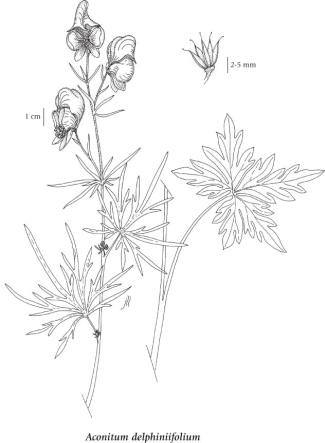Aconitum delphiniifolium DC.
mountain monkshood (larkspurleaf monkshood)
Ranunculaceae (Buttercup family)
Introduction to Vascular Plants
mountain monkshood (larkspurleaf monkshood)
Ranunculaceae (Buttercup family)
Introduction to Vascular Plants
Species Information
General:
Perennial herb from a tuberous taproot; stems erect, slender, 10-120 cm tall, smooth to nearly so below, spreading recurved-hairy above (in inflorescence).
Leaves:
Mostly stem leaves, alternate, stalked, 3-15 cm wide, palmately divided to base (or sometimes nearly so) into 5 segments, the margins cleft into narrow, linear-oblong lobes.
Flowers:
Inflorescence a terminal, 3- to 15-flowered, open raceme, the flowers bilaterally symmetric, usually blue or purple, sometimes greenish-purple, yellowish, or white, 20-40 mm long from tips of lower sepals to top of hood; flower stalks slender, ascending; petals 2, distinct, concealed in hood, long-clawed, spurred at apex; sepals 5, the lower 2 flat, 9-20 mm long, the lateral 2 round kidney-shaped, the upper sepal (the hood) somewhat sac-like, crescent-shaped to hemispheric, beaked, 10-24 mm long from receptacle to top of hood, 13-30 mm wide from receptacle to beak tip; pistils 3 (-5).
Fruits:
Follicles, 3 (-5), 15-25 mm long, smooth to sparsely hairy; seeds about 3 mm long, longitudinally winged, with many transverse, membranous baffles.
Notes:
Highly toxic, especially roots and seeds, causing death in livestock and humans.
Illustration

If more than one illustration is available for a species (e.g., separate illustrations were provided for two subspecies) then links to the separate images will be provided below. Note that individual subspecies or varietal illustrations are not always available.
Illustration Source: The Illustrated Flora of British Columbia
Ecology
Ecological Framework for Aconitum delphiniifolium
The table below shows the species-specific information calculated from
original data (BEC database) provided by the BC Ministry of Forests and Range.
(Updated August, 2013)
The table below shows the species-specific information calculated from
original data (BEC database) provided by the BC Ministry of Forests and Range.
(Updated August, 2013)
| Site Information |
Value / Class |
||
|
Avg |
Min |
Max |
|
| Elevation
(metres) |
1412 | 6 | 2440 |
| Slope
Gradient (%) |
22 | 0 | 300 |
|
Aspect (degrees) |
169 | 0 | 360 |
| Soil
Moisture Regime (SMR) [0 - very xeric; 4 - mesic; 8 - hydric] |
4 | 0 | 8 |
| Modal
Nutrient Regime
Class |
C | ||
| #
of field plots species was recorded in: |
856 | ||
| Modal
BEC Zone Class |
ESSF | ||
|
All BEC Zones (# of stations/zone) species was recorded in |
AT(3), BAFA(208), BWBS(62), CMA(2), CWH(1), ESSF(218), ICH(7), IDF(1), IMA(2), MH(17), MS(4), SBS(59), SWB(201) | ||
|
Source:
Klinkenberg 2013
|
|||
Habitat and Range
Moist to mesic meadows, thickets, streambanks, tundra and open forests from the montane to the alpine zones; frequent in BC north of 53degreeN; amphiberingian, N to AK, YT and NT, E to AB; E Asia.Status Information
Synonyms
Synonyms and Alternate Names:
Aconitum delphiniifolium subsp. delphiniifolium DC.